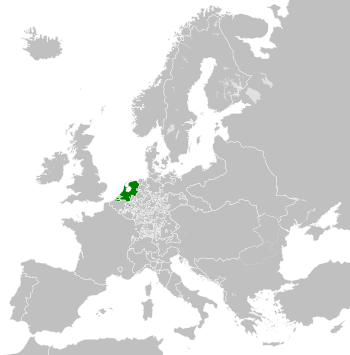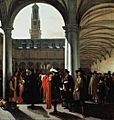Dutch Republic facts for kids
Quick facts for kids
Republic of the Seven United Netherlands
Republiek der Zeven Verenigde Nederlanden
|
|||||||||
|---|---|---|---|---|---|---|---|---|---|
| 1588–1795 | |||||||||
|
|
|||||||||

Location of the Dutch Republic in 1789
|
|||||||||
| Capital | Amsterdam | ||||||||
| Common languages | Dutch, Zeelandic, West Flemish, Dutch Low Saxon, West Frisian | ||||||||
| Religion | Dutch Reformed | ||||||||
| Government | Confederative republic | ||||||||
| Stadtholder | |||||||||
|
• 1581–1584
|
William I (first) | ||||||||
|
• 1751–1795
|
William V (last) | ||||||||
| Grand Pensionary | |||||||||
|
• 1581–1585
|
Paulus Buys (first) | ||||||||
|
• 1787–1795
|
Laurens van de Spiegel (last) | ||||||||
| Legislature | States General | ||||||||
|
• State council
|
Council of State | ||||||||
| Historical era | Early modern | ||||||||
| 23 January 1579 | |||||||||
| 26 July 1581 | |||||||||
| 30 January 1648 | |||||||||
| 19 January 1795 | |||||||||
| Population | |||||||||
|
• 1795
|
1880500 | ||||||||
| Currency | Guilder | ||||||||
|
|||||||||
| Today part of | |||||||||
The Dutch Republic was a powerful country in Europe. It was officially called the Republic of the Seven United Netherlands. This country existed from 1581 to 1795. It was a group of seven independent areas, called provinces, that worked together.
The Dutch Republic was a very important country. It came before the modern Netherlands. It was known for its trade, art, and science. Even though it was a republic, its main leader, the Stadtholder, often came from the same family. This made the position almost like a king's.
Contents
How the Dutch Republic Started
The Dutch Republic was born out of a long fight. This fight was against the powerful Habsburg rulers of Spain. These rulers controlled the area we now call the Netherlands.
Freedom from Spain
The people in the Netherlands wanted more freedom. They especially wanted to practice their own religion. This led to the Eighty Years' War, which started in 1568. In 1579, several northern provinces joined together. They signed the Union of Utrecht. This agreement helped them fight Spain as one group.
In 1581, these provinces took a big step. They officially declared their independence from Spain. This act was called the Act of Abjuration. It was like saying "we are no longer part of your kingdom." This moment is often seen as the start of the Dutch Republic.
Ending the War
The war with Spain continued for many years. Finally, in 1648, the Peace of Münster was signed. This treaty officially recognized the Dutch Republic as an independent country. It was a huge victory for the new nation.
How the Republic Was Governed
The Dutch Republic was a unique type of government. It was a confederation. This means it was a group of independent states that joined together. Each province had its own government.
The States General
The main government for the whole republic was the States General. This was a meeting of representatives from each of the seven provinces. They made decisions about war, peace, and foreign policy. However, each province had to agree to important decisions. This could sometimes make things slow.
The Stadtholder
The Stadtholder was a very important leader. This person was often in charge of the army and navy. They also had a lot of political power. The Stadtholder position often went to members of the House of Orange-Nassau family. This family included famous leaders like William the Silent. Over time, the Stadtholder position became almost like a hereditary role. This meant it was passed down from parent to child.
The Grand Pensionary
Another key figure was the Grand Pensionary. This person was the most important official in the province of Holland. Holland was the richest and most powerful province. The Grand Pensionary often acted as the main diplomat and political leader for the entire republic. They worked closely with the States General.
Life in the Dutch Republic
The Dutch Republic was a very successful country. It became rich through trade and exploration. This period is often called the Dutch Golden Age.
Trade and Economy
The Dutch were amazing sailors and traders. They built a huge trading empire. The Dutch East India Company was one of the most powerful companies in the world. It traded spices, silks, and other goods from Asia. Amsterdam became a major center for trade and finance. The Dutch guilder was their currency.
Art and Science
During the Golden Age, art and science also thrived. Famous painters like Rembrandt and Johannes Vermeer created masterpieces. Scientists like Christiaan Huygens made important discoveries. There was a strong focus on learning and new ideas.
Religion
The main religion in the Dutch Republic was Dutch Reformed. However, the republic was generally more tolerant of different religions than other European countries at the time. This tolerance helped attract skilled people from all over Europe.
The End of the Republic
The Dutch Republic lasted for over 200 years. But by the late 1700s, it faced many challenges. There were political disagreements and economic problems.
In 1795, French revolutionary armies invaded the Netherlands. With the help of Dutch supporters, they overthrew the republic. This led to the creation of the Batavian Republic. This new republic was more like France. It marked the end of the old Dutch Republic.
Images for kids
-
Silver coin: 1 ducaton Overijssel – 1734
-
Silver coin: 1 ducaton Utrecht – 1772
-
Silver coin: 1 ducaton Holland – 1780
-
Silver coin: 1 ducaton Friesland – 1784
-
Silver coin: 1 ducaton Zeeland – 1790
-
Silver coin: 1 ducaton Gelderland – 1792
-
Silver coin: 3 gulder Utrecht –- 1795
-
Dutch East India Company factory in Hugli-Chuchura, Mughal Bengal. Painting by Hendrik van Schuylenburgh, 1665
See also
 In Spanish: Provincias Unidas de los Países Bajos para niños
In Spanish: Provincias Unidas de los Países Bajos para niños













